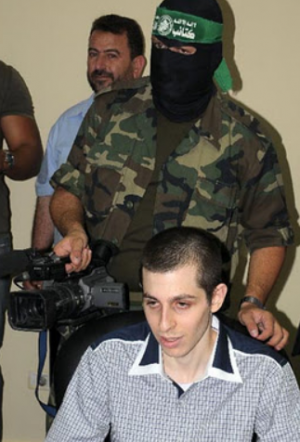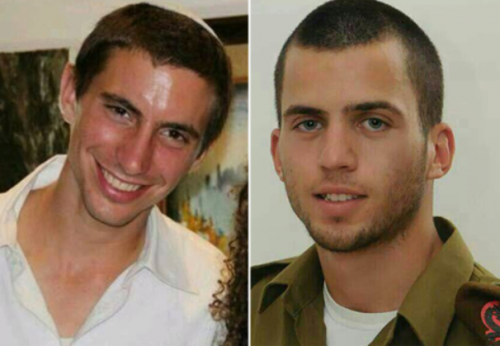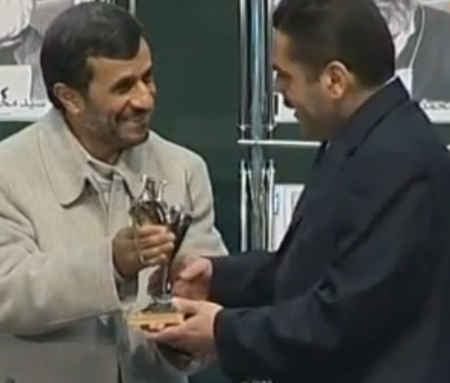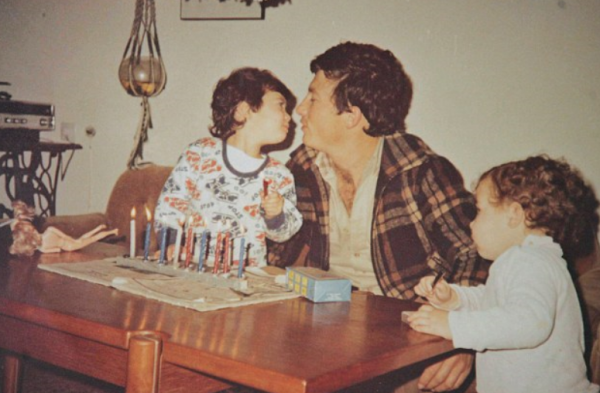The Palestinian Prisoner-Exchange Extortion Racket
Lopsided prisoner exchanges set terrorists free, like Samir Kuntar

In two recent posts (see here and here) we reported on the December 20 assassination of Lebanese Druze terrorist Samir Kuntar in Jaramana, a suburb of Damascus.
As we highlighted, Kuntar received three life sentences for his role in a 1979 terrorist attack which brutally devastated an entire Israeli family.
I don't celebrate death, but Samir Kuntar was the living embodiment of evil and his death is a blessing to the world https://t.co/qGsS5aSwaF
— Avi Mayer (@AviMayer) December 20, 2015
Kuntar was caught at the scene of the attack after a shootout with police and was convicted of murder.
Then, he spent 29 years in an Israeli jail. But in 2008, in what is widely considered to be the most gut-wrenching of all Israeli prisoner exchanges, he was released for the bodies of Ehud Goldwasser and Eldad Regev, IDF soldiers who were captured in July 2006 in the cross-border raid that sparked the second Lebanon War.
In addition to Kuntar, Israel also set free at the time four other Hezbollah fighters and returned the bodies of some 200 others.
The pivotal operational role that Kuntar has reportedly played over the last seven years following his release from prison—serving as “an important symbol for Hezbollah”, building up Hezbollah’s terrorist infrastructure in the Syrian Golan Heights, and working to open up a new front against Israel along its border with Syria—underscores the “slippery slope” of Israeli-Palestinian lopsided prisoner swaps.
Report: #Kuntar planning major #terror attack on #Israel when he was killedhttps://t.co/okC3KjEBeG pic.twitter.com/gvdi4iJH3P
— Ynetnews (@ynetnews) December 20, 2015
It’s a situation where Israel is increasingly being forced to pay unreasonable prices for the return of its POWs.
Critics have long argued that releasing convicted Palestinian terrorists “with blood on their hands” causes the murder and kidnapping of more Israelis.
As Israel has been increasingly compelled to negotiate with terrorist organizations for the release of its captured soldiers, what’s developed over the years is an “insane formula” where hundreds of convicted murderers serving life sentences for attacks on Israelis have been freed for one or a couple of abducted IDF soldiers—or their remains.
Those opposed to this policy insist that these lopsided prisoner swaps dramatically enlarges the pool of terrorists who harbor a strong desire to strike at Israel.
But the increasingly exaggerated prices that Israel has paid for the release of live IDF prisoners, or as is typically the case, their corpses, goes beyond this danger. Put simply: lopsided prisoner exchanges contributes greatly to the motivation of Palestinian organizations to abduct more Israeli soldiers.
Basically, Palestinian organizations have a huge incentive to scheme to kidnap soldiers (or civilians) so that murderers can be ransomed free.
The upshot is that for the past thirty years anti-Israel terrorist groups—from Hamas, to the PFLP, to Hezbollah—have been spending much of their time running what amounts to an extortion racket.
From Samir Kuntar to Leon Klinghoffer
As we noted in our prior posts, Kuntar became infamous for carrying out a heinous raid on the northern Israeli coastal city of Nahariya, just six miles south of the Lebanese border, on April 22, 1979.
There, he and three other terrorists kidnapped an Israeli family. Kuntar, who was 16 at the time and a member of the Palestine Liberation Front, was responsible for killing four-year-old Einat Haran on Nahariya’s beach. In an act of egregious brutality, he reportedly smashed her skull in against a rock with his rifle butt.
עינת ויעל הרן ז"ל.https://t.co/LGF7l4rbgHhttps://t.co/N9pNtV4fR8 pic.twitter.com/5X8krckO49
— Gal Berger גל ברגר (@galberger) December 20, 2015
Three other Israelis, including Danny Haran—Einat’s father—who Kuntar killed in front of his daughter so that “his death would be the last sight she would ever see”, according to eyewitness accounts—were also murdered in the attack.
Einat’s sister, two-year-old Yael, was killed when her mother accidentally smothered her during the attack.
In a desperate effort to save their lives, Smadar Haran kept her hand over her little girl’s mouth to keep her quiet. Years later, in a harrowing May 2003 Washington Post editorial (“The World Should Know What He Did to My Family”) that’s gone viral on social media over the last 48 hours, Smadar Haran Kaiser described to the world how she hid from Kuntar by hiding in her apartment’s crawl space—just like her mother “had hidden from the Nazis during the Holocaust”.
The World Should Know What He Did to My Family
PHOTO: Kuntar in Nazi salute Hezbollah rallyhttps://t.co/yZg6KvKO0i pic.twitter.com/fdJUfk70XJ— Josh Block (@JoshBlockDC) December 20, 2015
Back in the spring of 2003, Haran Kaiser had a good reason for insisting that the international community should know about Kuntar’s “unimaginable cruelty”.
U.S. Special Forces had just captured Abu (Muhammed) Abbas that April. He was the infamous mastermind of the 1985 hijacking of the Italian cruise ship Achille Lauro off the coast of Egypt.
The hijackers kept the ship’s crew and 400-plus passengers hostage for two days. Then they shot a disabled Jewish-American tourist, Leon Klinghoffer, dumping him overboard into the sea with his wheelchair.
Writing in 2003, Haran Kaiser was well aware that the WaPo’s readers would know about Klinghoffer’s murder—it was an act of terrorism that had received massive international media coverage.
But outside of Israel, few people knew that Kuntar murdered her husband and children, or that Abu Abbas concocted the Achille Lauro attack in order to gain the release of fifty prisoners being held in Israel—especially Kuntar, who was the only detainee named specifically.
Haran Kaiser was determined that the world should know about Kuntar’s heinous attack on Nahariya that destroyed her family and had “taken less than an hour in the middle of the night”.
She also had another motive for writing—she wanted to make sure that Abu Abbas would be prosecuted in the U.S.
As for Kuntar, back then she was certain that he would remain “locked up in an Israeli jail for life”. As she notes in her 2003 op-ed, the late former Prime Minister Yitzhak Rabin had given her his word:
I am determined that Samir Kuntar should never be released from prison. In 1984, I had to fight my own government not to release him as a part of an exchange for several Israeli soldiers who were POWs in Lebanon. I understood, of course, that the families of those POWs would gladly have agreed to the release of an Arab terrorist to get their sons back. But I told Yitzhak Rabin, then defense minister, that the blood of my family was a red as that of the POWs. Israel has always taken a position of refusing to negotiate with terrorists. If they were going to make an exception, let it be for a terrorist who was not as cruel as Kuntar. ‘Your job is not to be emotional,’ I told Rabin, ‘but to act rationally,’ And he did. So Kuntar remains in prison”.
Five years later, though, he would be a free man.
Israel’s Lopsided Prisoner Swaps
Since the mid-1950s Israel has released nearly 8,000 Palestinian detainees to free fewer than 20 of its soldiers, including staff sergeant Gilad Shalit. After spending five years in captivity, Shalit was exchanged in 2011 for 1,027 prisoners, together responsible for the murder of nearly 600 Israeli civilians.
To be sure, Israel has always made great efforts to bring its captives home.
That’s as it should be.
As noted by Reuven Pedatzur in a compelling 2011 article published in Haaretz, negotiation for the return of POWs “finds support and reinforcement” in Jewish tradition, where the concept of “pidyon shevuyim” (the ransoming of captives) carries importance in halakha (Jewish religious law) and was considered a great mitzvah by leading commentators, including Maimonides.
It’s also the organizational ethos of the IDF that the army doesn’t leave soldiers in the field, part of the “unwritten contract” between the State of Israel and the young citizens that it drafts into its army.
Pedatzur rightly notes that in the aftermath of wars with the Arab states, prisoner exchanges didn’t generate a public debate and “were fully accepted”:
In most cases the price Israel paid was high—usually because in wars, the number of enemy soldiers captured by the IDF was far higher than the number of Israeli soldiers taken captive by the Arab armies”.
So, for example, after the Sinai war of 1956, Israel returned 5,500 Egyptian soldiers for four IDF POWs. In the Six Day War of 1967, 15 Israeli soldiers were taken captive—to get them back Israel exchanged 4,338 soldiers and 889 civilians to Egypt, 533 soldiers and 366 civilians to Jordan, and 367 soldiers and 205 civilians to Syria. And after the Yom Kippur War, Israel released 8,372 POWs to Egypt and 392 to Syria to bring home 314 Israeli troops.
As Pedatzur explains it,
This sort of arrangement, along with the consensus over prisoner exchanges, began to go awry when Israel was compelled to negotiate with terrorist organizations for the release of its soldiers…confronting Israeli governments with a new type of dilemma: The candidates for exchange were no longer soldiers from regular armies, for whom there were known rules of the game, to whom the rules of the various Geneva Conventions apply. The agonizing was now over whether to free terrorists who perpetrated murderous attacks in return for any abducted Israelis. And after the decision was made to free even convicted terrorists, the question of the price arose—because, again, the wounded are not left in the field, and ransom must be arranged”.
The history of Israel’s prisoner swaps, like the infamous “Jibril deal” of May 1985, shows how, as Pedatuzur and others have argued, the “sacrosanct precept of the ransom of captives has backfired”. Then, after nine months of negotiating with the Popular Front for the Liberation of Palestine’s (PFLP) General Command, Israel swapped 3 Israeli soldiers for 1,150 hard-core terrorists, including Japanese-born Muslim convert Kozo Okamoto, one of the gunmen who killed 26 people in the 1972 Lod airport massacre:
Of the 364 prisoners released in the Tennenbaum deal of January 2004 (involving the return to Israel of Israeli civilian Elhanan Tennenbaum and the bodies of three IDF soldiers), who went back to the occupied territories, 30 percent were rearrested by Israel for terrorist activities. Of 238 prisoners freed in the Jibril deal who returned to the territories, 48 percent were imprisoned again. One of them Louie Sa’die, established a broad infrastructure for terrorist attacks in the northern West Bank after his release, which led to 30 Israelis being killed and another 300 wounded. He was liquidated in 2005”.
According to Almagor, the Israeli association for terror victims, from 2000-2011, 180 Israelis were killed at the hands of terrorists freed in previous prisoner swaps.
So ever since Prime Minister Benjamin Netanyahu agreed to the release of 1,027 Palestinian prisoners in exchange for a single Israeli soldier and tank crewman, Gilad Shalit, his opponents have been warning that further kidnappings were “simply a matter of time”.
The Fight to Return the Bodies of Slain IDF Soldiers Hadar Goldin and Oron Shaul
This past weekend, only a day before the airstrike that killed the notorious child-murderer Samir Kuntar, The Jerusalem Post reported that Hamas is vowing to “repeat the success of the Schalit swap” by bartering with Israel over the remains of two IDF soldiers: Golani Brigade soldier St.-Sgt. Oron Shaul (22), who was killed in action during an ambush in Gaza City’s Shejaia neighborhood in 2014, and Lt. Hadar Goldin (23), from the Givati Brigade’s Reconnaissance Company, who was killed in a Hamas tunnel in Rafah during Operation Protective Edge.
The families of Shaul and Goldin have been demanding for over a year and a half that the Israeli “government do more” to recover their sons’ remains. Some politicians are reportedly saying that the Netanyahu government is trying to keep the families quiet.
They’ve been anything but that.
Last July, Tzur Goldin spoke at the 10th annual summit of Christians United for Israel (CUFI), where by all accounts he delivered an emotional and heartfelt speech to thousands of American Christian evangelicals, pleading to help him return his twin brother’s body for burial.
In it, he said that
what Hamas terrorists did and are doing by holding my brother’s body, it is a crime. It is an outrage against humanity. And I’m not going to accept it. I reject it, and all good people must reject it with me…Please help me to ensure that he shall never ever be abandoned”.
And just last week the parents of Shaul held a press conference where they insisted that “The current situation has to change. This requires us to change our strategy. We have no doubt that we must think differently in order to bring Oron and Hadar home”.
In an unusual step, Oron’s mother, Zehava Shaul, who appears to be holding on to the hope that her son is still alive (even though the IDF Rabbinate has classified him and Goldin as dead, but whose place of burial is unknown), reportedly appealed directly to Hamas leader Ismail Haniyeh:
I am turning to you again, for a second time. I want to believe you. Present me with concrete evidence on the condition of Oron. We will turn over the country, and the world, to ensure that the deal [for his return] will be carried out”.
According to The Jerusalem Post report, Hamas is refusing to discuss the issue until Israel releases all of the Palestinian detainees who were traded for Gilad Shalit and who were re-arrested last summer after Hamas-affiliated terrorists abducted and murdered three Israeli teenagers in Gush Etzion.
But a rising new Hamas leader—who was himself released from an Israeli jail just four years ago in the Gilad Shalit prisoner swap back in 2011—may bring the Shaul and Goldin families some relief. As reported this weekend by Middle East analyst Avi Issacharoff for The Times of Israel, Yahya Sanwar, a high-ranking Hamas operative, is emerging as Hamas’ “uncompromising new strongman in Gaza”. And he seems to be interested in a prisoner exchange:
Sanwar won the title of Hamas’s Prisoner Number One in Israel. During those years [in jail] he attempted, without much success, to plan terror attacks, mainly kidnappings whose purpose was to bring about his release…When the [Shalit] deal was completed and the prisoners were taken to Gaza, Sanwar was chosen to give a speech in their name. Standing before the crowd of approximately 200,000 people who attended the official reception, Sanwar…promised that he would not forget he prisoners who remained behind bars…And so the man whom Prime Minister Benjamin Netanyahu released from prison is quickly becoming the State of Israel’s No. 1 enemy…Will he be the one to lead another war against Israel? Not necessarily. But we can be sure of one thing—he will work hard for another prisoner-exchange deal, on terms still less advantageous to Israel than the Shalit exchange, and even if the kidnapping of Israeli soldiers should result in a large-scale conflict”.
Conclusion
For the past three decades, Israel has been forced to exchange scores of incarcerated terrorists for a mere handful of its POWs. In the majority of these lopsided prisoner swaps the Israeli soldiers had already been killed and came home in body bags. And in many cases the freed terrorists have gone on to perpetrate further terror attacks.
Such was the case with Samir Kuntar.
Back in 1979 Kuntar would drag a four-year-old child from her bed in the dead of night, murdering her father in front of her, and then smashing in her head.
Kuntar was supposed to rot in jail. But Kuntar had friends, and they conspired to engineer his release. In 1985, one such villainous colleague came up with an elaborate plot to hijack a cruise ship, harming more innocents with the goal of ransoming the depraved child-killer free. It almost worked.
Then, in 2008 it was Israel who let him go. Kuntar was released to ease the suffering of several families who after two long, excruciating years were finally able to give their sons a proper burial.
For Israel, the agonizing decisions regarding the release of captive military personnel has pit the state against the families of the victims of terror and the grieving families of slain IDF soldiers, and those missing in action, or held in contravention to the rules of humanitarian international law.
There are no easy answers.
As Prof. Daniel Bar-Tal of Tel Aviv University’s School of Education noted back in 2009, when Israelis took positions for and against the prospective prisoner-exchange deal for IDF soldier Gilad Shalit:
The differences between the camps don’t represent a dichotomy but rather should be seen as the two sides of a genuinely terrible dilemma…Gilad Shalit is a victim who was violently kidnapped, in a way Israelis do not consider to be a normative means of struggle. Therefore one side says he should be returned at any price. But the families of those killed in terrorist attacks and the people who were wounded in those attacks are victims too, and they say that no price should be paid to the murderers…no side is right, and no side is wrong”.
For the most part, Israelis have sided with the troops. Efforts to free Gilad Shalid from captivity, for example, became a rallying cry for thousands of Israelis who took to the streets and to social media to urge their government to do more to secure his release. And despite fierce opposition from the families of terror victims, and some members of the Israeli government, the deal to free Shalit was backed by an Israeli cabinet majority of 26 to 3.
This week a senior leader of Hamas is reportedly making plans to once again use the corpses of dead Jews as bargaining chips. But new legislation, passed last year, now places some limitations on prisoner-exchange deals. Still, the law is full of loopholes and doesn’t apply to current prisoners. So the question remains how Israel will respond.
The release of 78 Palestinian terror convicts in the context of the aborted peace talks last year, many of them responsible for notorious terror attacks, has exacerbated the criticism. That said, Israeli society largely continues to sympathize with missing POWs and their desperate families, like the Shauls and the Goldins—the latest pawns in the Palestinian prisoner-exchange extortion racket.
Families of victims of #Samir #Kuntar: A historic justice has been done#SamirQantarhttps://t.co/KyvDhufOg0 pic.twitter.com/LCrSaQFUgZ
— Ynetnews (@ynetnews) December 20, 2015
————————————-
Miriam F. Elman is an associate professor of political science at the Maxwell School of Citizenship & Public Affairs, Syracuse University. She is the editor of five books and the author of over 60 journal articles, book chapters, and government reports on topics related to international and national security, religion and politics in the Middle East, and the Israeli-Palestinian conflict. Follow her on Twitter @MiriamElman
 DONATE
DONATE
Donations tax deductible
to the full extent allowed by law.
















Comments
There are several unassailable arguments FOR the death penalty.
This is just one…
The problem is that the Israelis, being of Western mores and beliefs, don’t understand the fine art of negotiating in the souk.
It’s simple: like for like and in equal measure.
Hamas has a captured Israeli for trade? I trade one, and only one, captured hard boy.
Hamas has the dead remains of a captured Israeli for trade? I provide them with the dead remains of a hard boy. If I don’t have any, I MAKE ONE.
None of this trading hundreds or thousands of terrorists for the bones of one soldier. That’s not how the souk works.
Catch, release, and exterminate, is a good model if you can keep it up consistently.
https://www.youtube.com/watch?v=5JU326dvQ2g
Technological solution: surgically-implanted GPS trackers and a few cruise missiles.
This is a gross distortion of the truth. It is indeed a mitzvah to ransom captives, but only if it can be done for no more than they would fetch on the open market if sold as slaves. That doesn’t create any incentives, because slavers will always be able to get that amount for them no matter what we do. The knowledge that there’s always a market for Jewish prisoners merely ensures that pirates won’t kill the weaker captives as unsaleable.
But Jewish law specifically forbids ransoming prisoners for more than their value as slaves, so as not to create an incentive to kidnap more Jews. Since today there is no market for slaves, the default price for captives is zero. If Israel refuses to pay ransom, there will be no incentive to kidnap soldiers in the first place. And the halacha is clear that preventing future kidnappings outweighs getting current captives back. And that’s even before considering all the innocent people whom the released prisoners will kill.
Israel needs to have the death penalty and enforce it. It’s quite Biblical. Rope greased with lard will do the trick. A rope was good enough for the Nazis at Nuremberg and will do just fine for the heirs of the Nazis.
I would simply use Arabic rules of war. No prisoners. Period.
What are you talking about? Arabic rules of war certainly involve taking prisoners.